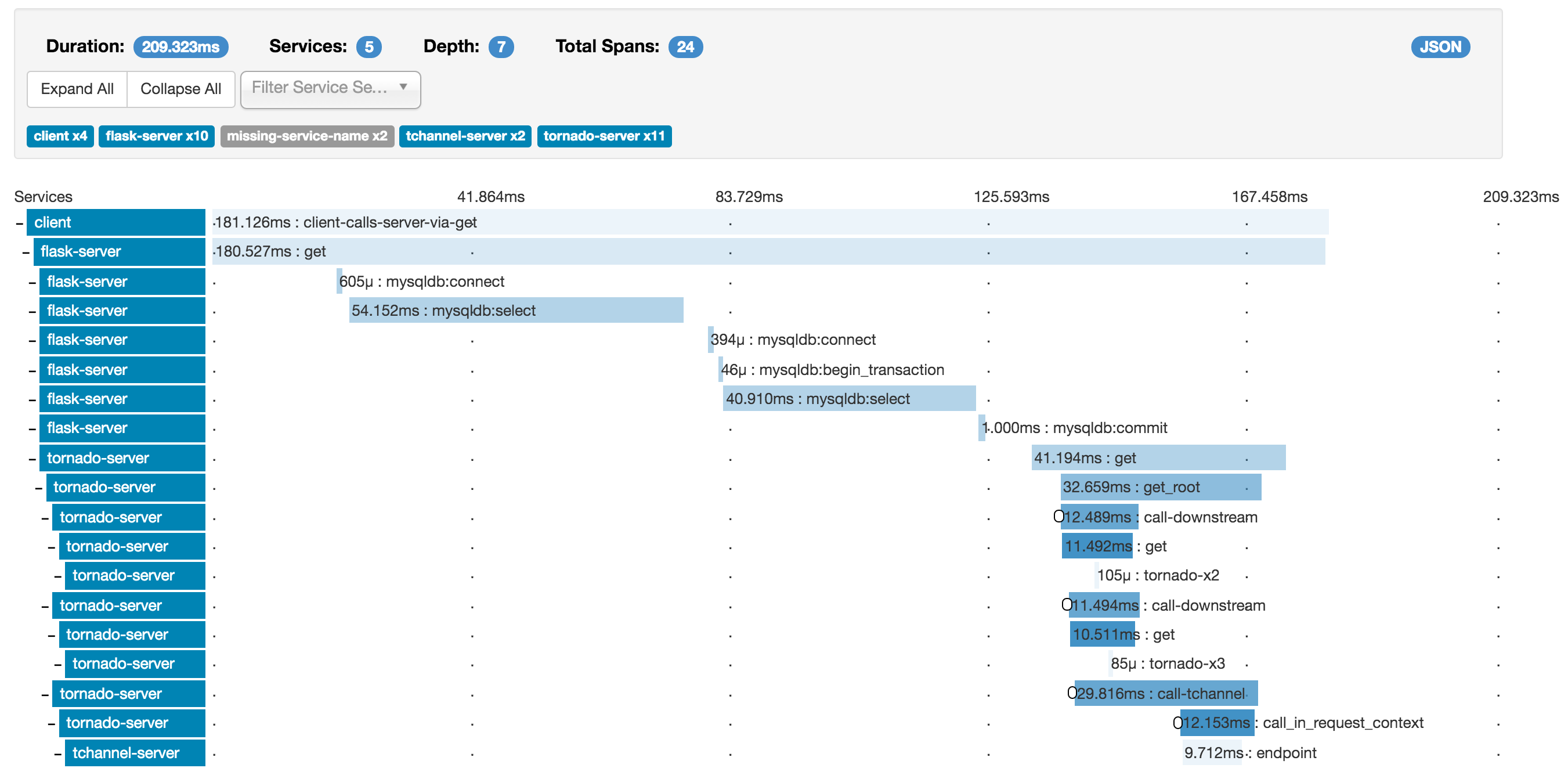服務化改造實踐(三) | Dubbo + Zipkin
在這個背景下,Google 發表了 Dapper 的論文,描述了如何通過一個分布式追蹤系統解決上述問題。基於該論文,各大互聯網公司實現並部署了自己的分布式追蹤系統,其中比較出名的有阿裏巴巴的 EagleEye。本文中提到的 Zipkin 是 Twitter 公司開源的分布式追蹤系統。下面會詳細介紹如何在 Dubbo 中使用 Zipkin 來實現分布式追蹤。
Zipkin 簡介
Zipkin 是基於 Dapper 論文實現,由 Twitter 開源的分布式追蹤系統,通過收集分布式服務執行時間的信息來達到追蹤服務調用鏈路、以及分析服務執行延遲等目的。
Zipkin 架構

Collector 收集器、Storage 存儲、API、UI 用戶界面等幾部分構成了 Zipkin Server 部分,對應於 GitHub 上 openzipkin/zipkin 這個項目。而收集應用中調用的耗時信息並將其上報的組件與應用共生,並擁有各個語言的實現版本,其中 Java 的實現是 GitHub 上 openzipkin/brave。除了 Java 客戶端實現之外,openzipkin 還提供了許多其他語言的實現,其中包括了 go、php、JavaScript、.net、ruby 等,具體列表可以參閱 Zipkin 的 Exiting instrumentations。
Zipkin 的工作過程
當用戶發起一次調用時,Zipkin 的客戶端會在入口處為整條調用鏈路生成一個全局唯一的 trace id,並為這條鏈路中的每一次分布式調用生成一個 span id。span 與 span 之間可以有父子嵌套關系,代表分布式調用中的上下遊關系。span 和 span 之間可以是兄弟關系,代表當前調用下的兩次子調用。一個 trace 由一組 span 組成,可以看成是由 trace 為根節點,span 為若幹個子節點的一棵樹。

Span 由調用邊界來分隔,在 Zipkin 中,調用邊界由以下四個 annotation 來表示:
- cs - Clent Sent 客戶端發送了請求
- sr - Server Receive 服務端接受到請求
- ss - Server Send 服務端處理完畢,向客戶端發送回應
- cr - Client Receive 客戶端收到結果
顯然,通過這四個 annotation 上的時間戳,可以輕易的知道一次完整的調用在不同階段的耗時,比如:
- sr - cs 代表了請求在網絡上的耗時
- ss - sr 代表了服務端處理請求的耗時
- cr - ss 代表了回應在網絡上的耗時
- cr - cs 代表了一次調用的整體耗時
Zipkin 會將 trace 相關的信息在調用鏈路上傳遞,並在每個調用邊界結束時異步的把當前調用的耗時信息上報給 Zipkin Server。Zipkin Server 在收到 trace 信息後,將其存儲起來,Zipkin 支持的存儲類型有 inMemory、MySql、Cassandra、以及 ElasticsSearch 幾種方式。隨後 Zipkin 的 Web UI 會通過 API 訪問的方式從存儲中將 trace 信息提取出來分析並展示,如下圖所示:

在 Dubbo 中使用
由於 Brave 對 Dubbo 已經主動做了支持,在 Dubbo 中集成基於 Zipkin 的鏈路追蹤變的十分簡單。下面會按照 Brave 中關於 Dubbo RPC 支持的指引來說明如何在 Dubbo 中使用 Zipkin。
安裝 Zipkin Server
按照 Zipkin 官方文檔中的快速開始 來安裝 Zipkin,如下所示:
$ curl -sSL https://zipkin.io/quickstart.sh | bash -s
$ java -jar zipkin.jar按照這種方式安裝的 Zipkin Server 使用的存儲類型是 inMemory 的。當服務器停機之後,所有收集到的 trace 信息會丟失,不適用於生產系統。如果在生產系統中使用,需要配置另外的存儲類型。Zipkin 支持 MySql、Cassandra、和 ElasticSearch。推薦使用 Cassandra 和 ElasticSearch,相關的配置請自行查閱官方文檔。
本文為了演示方便,使用的存儲是 inMemory 類型。成功啟動之後,可以在終端看到如下的提示:
$ java -jar zipkin.jar
Picked up JAVA_TOOL_OPTIONS: -Djava.awt.headless=true
********
** **
* *
** **
** **
** **
** **
********
****
****
**** ****
****** **** ***
****************************************************************************
******* **** ***
**** ****
**
**
***** ** ***** ** ** ** ** **
** ** ** * *** ** **** **
** ** ***** **** ** ** ***
****** ** ** ** ** ** ** **
:: Powered by Spring Boot :: (v2.0.5.RELEASE)
...
o.s.b.w.e.u.UndertowServletWebServer : Undertow started on port(s) 9411 (http) with context path ‘‘
2018-10-10 18:40:31.605 INFO 21072 --- [ main] z.s.ZipkinServer : Started ZipkinServer in 6.835 seconds (JVM running for 8.35)然後在瀏覽器中訪問 http://localhost:9411 驗證 WEB 界面。
配置 Maven 依賴
引入 Brave 依賴
新建一個新的 Java 工程,並在 pom.xml 中引入 Brave 相關的依賴如下:
<properties>
<brave.version>5.4.2</brave.version>
<zipkin-reporter.version>2.7.9</zipkin-reporter.version>
</properties>
<dependencyManagement>
<dependencies>
<!-- 引入 zipkin brave 的 BOM 文件 -->
<dependency>
<groupId>io.zipkin.brave</groupId>
<artifactId>brave-bom</artifactId>
<version>${brave.version}</version>
<type>pom</type>
<scope>import</scope>
</dependency>
<!-- 引入 zipkin repoter 的 BOM 文件 -->
<dependency>
<groupId>io.zipkin.reporter2</groupId>
<artifactId>zipkin-reporter-bom</artifactId>
<version>${zipkin-reporter.version}</version>
<type>pom</type>
<scope>import</scope>
</dependency>
</dependencies>
</dependencyManagement>
<dependencies>
<!-- 1. brave 對 dubbo 的集成 -->
<dependency>
<groupId>io.zipkin.brave</groupId>
<artifactId>brave-instrumentation-dubbo-rpc</artifactId>
</dependency>
<!-- 2. brave 的 spring bean 支持 -->
<dependency>
<groupId>io.zipkin.brave</groupId>
<artifactId>brave-spring-beans</artifactId>
</dependency>
<!-- 3. 在 SLF4J 的 MDC (Mapped Diagnostic Context) 中支持 traceId 和 spanId -->
<dependency>
<groupId>io.zipkin.brave</groupId>
<artifactId>brave-context-slf4j</artifactId>
</dependency>
<!-- 4. 使用 okhttp3 作為 reporter -->
<dependency>
<groupId>io.zipkin.reporter2</groupId>
<artifactId>zipkin-sender-okhttp3</artifactId>
</dependency>
</dependencies>其中:
- 引入 brave-instrumentation-dubbo-rpc,brave 對 dubbo 的支持:https://github.com/openzipkin/brave/blob/master/instrumentation/dubbo-rpc/README.md
- 引入 brave-spring-beans,brave 對 spring bean 的支持:https://github.com/openzipkin/brave/blob/master/spring-beans/README.md
- 引入 brave-context-slf4j,brave 對 SLF4J 的支持,可以在 MDC 中使用 traceId 和 spanId:https://github.com/openzipkin/brave/blob/master/context/slf4j/README.md
- 引入 zipkin-sender-okhttp3,使用 okhttp3 上報數據:https://github.com/openzipkin/zipkin-reporter-java
引入 Dubbo 相關依賴
Dubbo 相關的依賴是 Dubbo 本身以及 Zookeeper 客戶端,在下面的例子中,我們將會使用獨立的 Zookeeper Server 作為服務發現。
<dependencies>
<!-- 1. Zookeeper 客戶端依賴 -->
<dependency>
<groupId>org.apache.curator</groupId>
<artifactId>curator-framework</artifactId>
<version>2.12.0</version>
<exclusions>
<exclusion>
<groupId>io.netty</groupId>
<artifactId>netty</artifactId>
</exclusion>
</exclusions>
</dependency>
<!-- 2. Dubbo 依賴 -->
<dependency>
<groupId>com.alibaba</groupId>
<artifactId>dubbo</artifactId>
<version>2.6.2</version>
</dependency>
</dependencies>其中:
- Dubbo 這裏依賴獨立的 Zookeeper Server 做服務發現,這裏使用的客戶端是 Curator
- 引入 Dubbo 框架的依賴,原則上 2.6 的任何版本都是工作的,這裏使用的是 2.6.2 版本
實現
我們這裏構造的場景是一個有兩個節點的服務依賴鏈,也就是,當一個 Dubbo 客戶端調用服務 A 時,服務 A 將會繼續調用服務 B。在這個例子中,服務 A 是 greeting service,它所依賴的下遊服務服務 B 是 hello service。
定義服務接口
為此需要事先定義兩個服務接口 GreetingService 以及 HelloService
-
com.alibaba.dubbo.samples.api.GreetingService
package com.alibaba.dubbo.samples.api; public interface GreetingService { String greeting(String message); } -
com.alibaba.dubbo.samples.api.HelloService
package com.alibaba.dubbo.samples.api; public interface HelloService { String hello(String message); }
實現服務接口
為了區分對待,所有和 HelloService 相關的實現代碼都放在 hello 子包下,同理 GreetingService 相關的放在 greeting 子包下。
-
實現 com.alibaba.dubbo.samples.api.HelloService
package com.alibaba.dubbo.samples.service.hello; import com.alibaba.dubbo.samples.api.HelloService; import java.util.Random; public class HelloServiceImpl implements HelloService { @Override public String hello(String message) { try { // 通過 sleep 模擬業務邏輯處理時間 Thread.sleep(new Random(System.currentTimeMillis()).nextInt(1000)); } catch (InterruptedException e) { // no op } return "hello, " + message; } } -
實現 com.alibaba.dubbo.samples.api.GreetingService
package com.alibaba.dubbo.samples.service.greeting; import com.alibaba.dubbo.samples.api.GreetingService; import com.alibaba.dubbo.samples.api.HelloService; import java.util.Random; public class GreetingServiceImpl implements GreetingService { // 下遊依賴服務,運行時靠 spring 容器註入 HelloService 的服務代理 private HelloService helloService; public void setHelloService(HelloService helloService) { this.helloService = helloService; } @Override public String greeting(String message) { try { // 通過 sleep 模擬業務邏輯處理時間 Thread.sleep(new Random(System.currentTimeMillis()).nextInt(1000)); } catch (InterruptedException e) { // no op } return "greeting, " + helloService.hello(message); } }這裏需要註意的是,GreetingServiceImpl 的實現中聲明了一個類型是 HelloService 的成員變量,並在 greeting 方法中,執行完自己邏輯之後又調用了 HelloService 上的 hello 方法。這裏的 helloService 的實現將會在運行態由外部註入,註入的不是 HelloServiceImpl 的實現,而是 HelloService 的遠程調用代理。通過這樣的方式,完成了在一個 Dubbo 服務中繼續調用另一個遠程 Dubbo 服務的目的。從鏈路追蹤的角度來說,客戶端調用 GreetingService 是一個 span,GreetingService 調用 HelloService 是另一個 span,並且兩者有父子關系,同屬於一個 trace,也就是屬於同一條調用鏈路。
另外,在 GreetingServiceImpl 和 HelloServiceImpl 的實現中,通過 Thread.sleep 來模擬了處理業務邏輯的耗時,以便在 Zipkin UI 上更好的展示。
配置
為了專註在展示如何使用 Zipkin 這一點上,本文在配置和編程模型上沒有采用更多的高級技術,而是使用了最傳統的 Spring XML 的配置方式,幫助讀者理解。更高級的通過 annotation 甚至 spring boot 的方式,讀者可以自行查閱 Dubbo 和 Zipkin 相關的文檔。
-
暴露 HelloService 服務
在 resouces/spring/hello-service.xml 中增加以下的配置來將 HelloServiceImpl 暴露成一個 Dubbo 服務:
- 使用了本地啟動的 Zookeeper Server 作為註冊中心,地址為默認值 zookeeper://127.0.0.1:2181
- 用 Dubbo 原生服務在端口 20880 上暴露服務
- 將 HelloServiceImpl 註冊成 id 是
helloService的 Spring Bean,這樣就可以在後續的<dubbo:service>中引用到這個實現類 - 通過
<dubbo:service>將 HelloServiceImpl 暴露成 Dubbo 服務
<!-- 定義 HelloService 的應用名 --> <dubbo:application name="hello-service-provider"/> <!-- 指定註冊中心地址 --> <dubbo:registry address="zookeeper://127.0.0.1:2181"/> <!-- 使用 Dubbo 原生協議在 20880 端口上暴露服務 --> <dubbo:protocol name="dubbo" port="20880"/> <!-- 將 HelloServiceImpl 的實現聲明成一個 spring bean --> <bean id="helloService" class="com.alibaba.dubbo.samples.service.hello.HelloServiceImpl"/> <!-- 將 HelloServiceImpl 聲明成一個 Dubbo 服務 --> <dubbo:service interface="com.alibaba.dubbo.samples.api.HelloService" ref="helloService"/> -
增加 Zipkin 相關的配置
在 resources/spring/hello-service.xml 中增加 Zipkin 相關的配置:
- 修改 dubbo 服務暴露的配置,添加 Zipkin 的 tracing filter 到 Dubbo 的 filter chain 中
- 按照 https://github.com/openzipkin/brave/blob/master/spring-beans/README.md 來配置 Zipkin 的 sender 和 tracing 的 spring bean
<!-- 1. 修改 dubbo 服務暴露配置,在 filter chain 中增加 zipkin 的 tracing 過濾器 --> <dubbo:service interface="com.alibaba.dubbo.samples.api.HelloService" ref="helloService" filter="tracing"/> <!-- 2. zipkin 相關的配置 --> <!-- 使用 OKHttp 來發送 trace 信息到 Zipkin Server。這裏的 Zipkin Server 啟動在本地 --> <bean id="sender" class="zipkin2.reporter.beans.OkHttpSenderFactoryBean"> <property name="endpoint" value="http://localhost:9411/api/v2/spans"/> </bean> <bean id="tracing" class="brave.spring.beans.TracingFactoryBean"> <property name="localServiceName" value="hello-service"/> <property name="spanReporter"> <bean class="zipkin2.reporter.beans.AsyncReporterFactoryBean"> <property name="sender" ref="sender"/> <!-- wait up to half a second for any in-flight spans on close --> <property name="closeTimeout" value="500"/> </bean> </property> <property name="currentTraceContext"> <bean class="brave.spring.beans.CurrentTraceContextFactoryBean"> <property name="scopeDecorators"> <bean class="brave.context.slf4j.MDCScopeDecorator" factory-method="create"/> </property> </bean> </property> </bean> -
增加 HelloService 的啟動類
在 com.alibaba.dubbo.samples.service.hello.Application 中通過 ClassPathXmlApplicationContext 讀取 剛才配置的 spring/hello-service.xml 來初始化一個 spring context 並啟動
package com.alibaba.dubbo.samples.service.hello; import org.springframework.context.support.ClassPathXmlApplicationContext; import java.io.IOException; public class Application { public static void main(String[] args) throws IOException { ClassPathXmlApplicationContext context = new ClassPathXmlApplicationContext("spring/hello-service.xml"); context.start(); System.out.println("Hello service started"); // press any key to exit System.in.read(); } } -
暴露 GreetingService 服務,並使用 Zipkin
在 resources/spring/greeting-service.xml 中配置 GreetingService。相關步驟與 HelloService 類似,不再贅述,重點關註如何在 GreetingService 中配置下遊服務的依賴。完整的 XML 配置如下:
<beans xmlns:xsi="http://www.w3.org/2001/XMLSchema-instance" xmlns:dubbo="http://dubbo.apache.org/schema/dubbo" xmlns="http://www.springframework.org/schema/beans" xsi:schemaLocation="http://www.springframework.org/schema/beans http://www.springframework.org/schema/beans/spring-beans.xsd http://dubbo.apache.org/schema/dubbo http://dubbo.apache.org/schema/dubbo/dubbo.xsd"> <!-- 1. 定義 GreetingService 的應用名 --> <dubbo:application name="greeting-service-provider"/> <!-- 2. 指定註冊中心地址 --> <dubbo:registry address="zookeeper://127.0.0.1:2181"/> <!-- 3. 使用 Dubbo 原生協議在 20881 端口上暴露服務 --> <dubbo:protocol name="dubbo" port="20881"/> <!-- 4. 聲明 HelloService 的遠程代理,並在 Dubbo 的 filter chain 中增加 tracing filter --> <dubbo:reference id="helloService" check="false" interface="com.alibaba.dubbo.samples.api.HelloService" filter="tracing"/> <!-- 5. 將 GreetingServiceImpl 的實現聲明成一個 spring bean,並將 HelloService 的遠程代理裝配進去 --> <bean id="greetingService" class="com.alibaba.dubbo.samples.service.greeting.GreetingServiceImpl"> <property name="helloService" ref="helloService"/> </bean> <!-- 6. 將 GreetingServiceImpl 聲明成一個 Dubbo 服務,並在 Dubbo 的 filter chain 中增加 tracing filter --> <dubbo:service interface="com.alibaba.dubbo.samples.api.GreetingService" ref="greetingService" filter="tracing"/> <!-- 7. zipkin 相關的配置 --> <bean id="sender" class="zipkin2.reporter.beans.OkHttpSenderFactoryBean"> <property name="endpoint" value="http://localhost:9411/api/v2/spans"/> </bean> <bean id="tracing" class="brave.spring.beans.TracingFactoryBean"> <property name="localServiceName" value="greeting-service"/> <property name="spanReporter"> <bean class="zipkin2.reporter.beans.AsyncReporterFactoryBean"> <property name="sender" ref="sender"/> <!-- wait up to half a second for any in-flight spans on close --> <property name="closeTimeout" value="500"/> </bean> </property> <property name="currentTraceContext"> <bean class="brave.spring.beans.CurrentTraceContextFactoryBean"> <property name="scopeDecorators"> <bean class="brave.context.slf4j.MDCScopeDecorator" factory-method="create"/> </property> </bean> </property> </bean> </beans>這裏的配置與上面的 HelloService 類似,需要重點關註的有兩點:
- 第 3 步中註意服務需要暴露在不同的端口上,否則會和 HelloService 沖突,本例中選擇的是 20881 這個端口
- 通過第 4 步先聲明 HelloService 的遠程代理,然後在第 5 步中將其組裝給 GreetingService 來完成服務上下遊依賴的聲明
增加 GreeeingService 的啟動類,與 HelloService 類似,通過 spring/greeting-service.xml 的配置來初始化一個新的 spring context 來完成。
package com.alibaba.dubbo.samples.service.greeting;
import org.springframework.context.support.ClassPathXmlApplicationContext;
import java.io.IOException;
public class Application {
public static void main(String[] args) throws IOException {
ClassPathXmlApplicationContext context = new ClassPathXmlApplicationContext("spring/greeting-service.xml");
context.start();
System.out.println("Greeting service started");
// press any key to exit
System.in.read();
}
}-
實現客戶端
通過 resources/spring/client.xml 初始化一個 spring context,從其中獲取 GreetingService 的遠程代理,發起遠程調用。
package com.alibaba.dubbo.samples.client; import com.alibaba.dubbo.samples.api.GreetingService; import org.springframework.context.support.ClassPathXmlApplicationContext; public class Application { public static void main(String[] args) { ClassPathXmlApplicationContext context = new ClassPathXmlApplicationContext("spring/client.xml"); context.start(); // 獲取遠程代理並發起調用 GreetingService greetingService = (GreetingService) context.getBean("greetingService"); System.out.println(greetingService.greeting("world")); } }resource/spring/client.xml 中的配置與 Dubbo 服務的配置類似,主要是配置遠程代理,以及配置 Zipkin
<beans xmlns:xsi="http://www.w3.org/2001/XMLSchema-instance" xmlns:dubbo="http://dubbo.apache.org/schema/dubbo" xmlns="http://www.springframework.org/schema/beans" xsi:schemaLocation="http://www.springframework.org/schema/beans http://www.springframework.org/schema/beans/spring-beans.xsd http://dubbo.apache.org/schema/dubbo http://dubbo.apache.org/schema/dubbo/dubbo.xsd"> <!-- 1. 定義 dubbo 客戶端的應用名 --> <dubbo:application name="dubbo-client"/> <!-- 2. 指定註冊中心地址 --> <dubbo:registry address="zookeeper://127.0.0.1:2181"/> <!-- 3. 聲明 GreetingService 的遠程代理,並在 Dubbo 的 filter chain 中增加 tracing filter --> <dubbo:reference id="greetingService" check="false" interface="com.alibaba.dubbo.samples.api.GreetingService" filter="tracing"/> <!-- 4. zipkin 相關的配置 --> <bean id="sender" class="zipkin2.reporter.beans.OkHttpSenderFactoryBean"> <property name="endpoint" value="http://localhost:9411/api/v2/spans"/> </bean> <bean id="tracing" class="brave.spring.beans.TracingFactoryBean"> <property name="localServiceName" value="client"/> <property name="spanReporter"> <bean class="zipkin2.reporter.beans.AsyncReporterFactoryBean"> <property name="sender" ref="sender"/> <!-- wait up to half a second for any in-flight spans on close --> <property name="closeTimeout" value="500"/> </bean> </property> <property name="currentTraceContext"> <bean class="brave.spring.beans.CurrentTraceContextFactoryBean"> <property name="scopeDecorators"> <bean class="brave.context.slf4j.MDCScopeDecorator" factory-method="create"/> </property> </bean> </property> </bean> </beans>
完成之後的工程的目錄結構如下:

運行
現在讓我們把整個鏈路運行起來,看看 Zipkin 鏈路追蹤的效果。
啟動 Zookeeper Server
執行以下命令在本地啟動一個 Zookeeper Server,如果沒有安裝,請自行從 ZooKeeper 官網 下載:
$ zkServer start啟動 Zipkin Server
執行以下命令在本地啟動一個 Zipkin Server:
$ curl -sSL https://zipkin.io/quickstart.sh | bash -s
$ java -jar zipkin.jar啟動 HelloService
使用下面的命令啟動 HelloService,當然也可以直接在 IDE 中啟動:
$ mvn exec:java -Dexec.mainClass=com.alibaba.dubbo.samples.service.hello.Application啟動成功後應該可以在終端上看到 “Hello service started” 的字樣。
啟動 GreetingService
使用下面的命令啟動 GreetingService,當然也可以直接在 IDE 中啟動:
$ mvn exec:java -Dexec.mainClass=com.alibaba.dubbo.samples.service.greeting.Application啟動成功後應該可以在終端上看到 “Greeting service started” 的字樣。
運行 Dubbo 客戶端
使用下面的命令運行 Dubbo 客戶端向 GreetingService 發起遠程調用,當然也可以直接在 IDE 中運行:
$ mvn exec:java -Dexec.mainClass=com.alibaba.dubbo.samples.client.Application執行成功後,客戶端會在終端上輸出 “greeting, hello, world”。
鏈路追蹤
打開瀏覽器訪問 "http://localhost:9411" 並通過 "Find Traces" 按鈕來搜索,可以找到剛剛調用的鏈路追蹤,效果如下圖所示:

還可以進一步的選擇每一個 span 來查看本次調用邊界內的詳情,比如,hello-service 這個 span 的詳情如下:

總結
本文介紹了鏈路追蹤的基本概念以及 Zipkin 的基本用法,然後用 Dubbo 構建了一條最簡單的調用鏈路,並引入了 Zipkin 做全鏈路追蹤。由於 Zipkin 對 Dubbo 做了很好的支持,整個集成的過程還是十分簡單明了的。
Zipkin 對 Dubbo 的支持是構建在 Dubbo 的 filter 擴展機制上的,有興趣的讀者可以通過 https://github.com/openzipkin/brave/blob/master/instrumentation/dubbo-rpc/src/main/java/brave/dubbo/rpc/TracingFilter.java 了解其實現細節。
本文中涉及的例子可以從 https://github.com/dubbo/dubbo-samples 中的 "dubbo-samples-zipkin" 子模塊中獲取。另外,spring-cloud-sleth 2.0 中開始 正式支持 Dubbo,相關的文章和例子後續計劃提供。
歡迎關註“阿裏巴巴中間件”,加入中間件開發者群,與技術同行。

服務化改造實踐(三) | Dubbo + Zipkin
